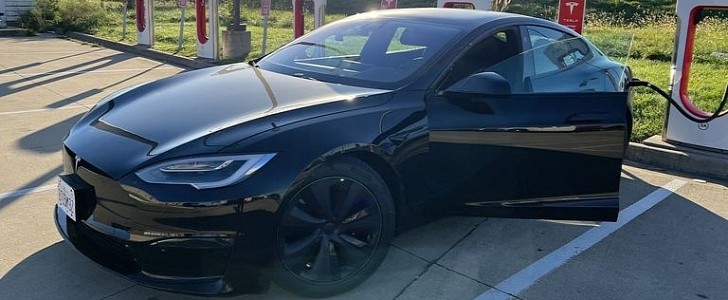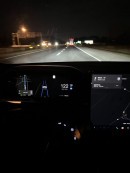A new EV Cannonball Record has been set, and it has been done in a Tesla. This time, a 2021 Tesla Model S Long Range was the vehicle of choice, and those who set the record had a previous achievement of this kind just a few years back. Here is what you need to know.
Ryan Levenson and Josh Allan set a new EV Cannonball Record for crossing the U.S. from East to West in 42 hours and 17 minutes. Yes, that includes charging the Tesla Model S Long Range. If we look at the previous record, set in a Porsche Taycan, the team beat it by two hours.
The previous record was set this January in 44 hours, 25 minutes, and 59 seconds. At the time, it broke a record held by a Tesla Model 3. All three results show that the U.S. EV charging infrastructure has reached a point where someone can cross the country from West to East in a day and a half, including charging.
The overall Cannonball Record stands at 25 hours and 39 minutes, which goes to show that EVs are closing in on conventional vehicle performance, but there is still a gap that is difficult to overcome with today's technology.
The team rented a 2021 Tesla Model S Long Range from Turo, Ryan told Road and Track, but they did ask permission from its owner to drive the vehicle for 7,000 miles (ca. 11,265 km) using a different set of wheels and tires over the course of a week-long, unlimited-mile rental.
Ryan Levenson explained that he was waiting for the delivery of his Tesla but figured out that the weather would change for the worse by the time that the vehicle arrived.
Therefore, he decided to rent a Tesla Model S from Los Angeles, rent a set of 19-inch Tesla alloy wheels complete with Michelin Pilot Sport 4 tires, and fit them on the EV before setting off to New York. Since the Cannonball Run only counts if the departure is from New York, the team proceeded to drive to the Red Ball Parking Garage in The Big Apple.
Ryan chose a set of OEM Tesla 19-inch Tempest wheels with no modifications, and he decided to run a higher pressure on them, opting for 47 psi (ca. 3.2 bar) instead of 40 psi (ca. 2.75 bar) on the way back from New York to Los Angeles. This was Ryan's third drive of this kind, as he first drove the Cannonball Run in a Tesla Model 3 before Alex Roy set his record in January 2018.
Levenson did this whole thing to promote his EV promotion and rental company, called The Kilowatts. What is more interesting to us about the entire thing is that he did not rely on radar detectors, Laser jammers, or even spotters for his record-setting run.
The team did have a radar detector on board, but it provided too many false alarms for the team and was turned off after less than an hour of use. The vehicle was not disguised in any way, and it was not fitted with any system to increase its range of capabilities. In other words, they used a bone-stock vehicle with the smallest wheels available and higher tire pressure.
Instead, Ryan Levenson opted for the Waze app to receive traffic alerts, but he first planned the route using an app called A Better Route Planner. The latter has the ability to calculate routes depending on various factors, which gave Ryan the confidence he needed to pursue his plan.
The team claims to have reached 155 mph (ca. 249 km/h) during the trip, and there is even a full time-lapse video of their run embedded below, so this should explain a few things. For those of you into statistics, the drive involved 24 stops to charge, each with an average of 18 minutes across all stops, which adds up to 7.2 hours standing still.
According to Ryan Levinson, he arrived at the charging station with a charge that was less than 10 percent and then left the charger the battery reached 50 percent.
As he told Road and Track, he encountered setbacks right after starting from New York, in Manhattan traffic, as well as near Albuquerque, because of road works.
Moreover, he also had to deal with charging snags. His estimate is that 60 to 90 minutes could have been shaved from the total time if a perfect run were to be made.
For an even quicker run to be achieved, those who would attempt it require more V3 250 kWh Superchargers, a modified car, or a different car. If you ask us, that vehicle would have to be an EV that has access to a high-speed charging infrastructure, available across the U.S. It should also come with an even larger range than a Tesla Model S Long Range, so that limits one's options today.
While we do cover events like these from time to time, please do not attempt to break this record or others like it.
The previous record was set this January in 44 hours, 25 minutes, and 59 seconds. At the time, it broke a record held by a Tesla Model 3. All three results show that the U.S. EV charging infrastructure has reached a point where someone can cross the country from West to East in a day and a half, including charging.
The overall Cannonball Record stands at 25 hours and 39 minutes, which goes to show that EVs are closing in on conventional vehicle performance, but there is still a gap that is difficult to overcome with today's technology.
The team rented a 2021 Tesla Model S Long Range from Turo, Ryan told Road and Track, but they did ask permission from its owner to drive the vehicle for 7,000 miles (ca. 11,265 km) using a different set of wheels and tires over the course of a week-long, unlimited-mile rental.
Ryan Levenson explained that he was waiting for the delivery of his Tesla but figured out that the weather would change for the worse by the time that the vehicle arrived.
Therefore, he decided to rent a Tesla Model S from Los Angeles, rent a set of 19-inch Tesla alloy wheels complete with Michelin Pilot Sport 4 tires, and fit them on the EV before setting off to New York. Since the Cannonball Run only counts if the departure is from New York, the team proceeded to drive to the Red Ball Parking Garage in The Big Apple.
Ryan chose a set of OEM Tesla 19-inch Tempest wheels with no modifications, and he decided to run a higher pressure on them, opting for 47 psi (ca. 3.2 bar) instead of 40 psi (ca. 2.75 bar) on the way back from New York to Los Angeles. This was Ryan's third drive of this kind, as he first drove the Cannonball Run in a Tesla Model 3 before Alex Roy set his record in January 2018.
Levenson did this whole thing to promote his EV promotion and rental company, called The Kilowatts. What is more interesting to us about the entire thing is that he did not rely on radar detectors, Laser jammers, or even spotters for his record-setting run.
The team did have a radar detector on board, but it provided too many false alarms for the team and was turned off after less than an hour of use. The vehicle was not disguised in any way, and it was not fitted with any system to increase its range of capabilities. In other words, they used a bone-stock vehicle with the smallest wheels available and higher tire pressure.
Instead, Ryan Levenson opted for the Waze app to receive traffic alerts, but he first planned the route using an app called A Better Route Planner. The latter has the ability to calculate routes depending on various factors, which gave Ryan the confidence he needed to pursue his plan.
The team claims to have reached 155 mph (ca. 249 km/h) during the trip, and there is even a full time-lapse video of their run embedded below, so this should explain a few things. For those of you into statistics, the drive involved 24 stops to charge, each with an average of 18 minutes across all stops, which adds up to 7.2 hours standing still.
According to Ryan Levinson, he arrived at the charging station with a charge that was less than 10 percent and then left the charger the battery reached 50 percent.
As he told Road and Track, he encountered setbacks right after starting from New York, in Manhattan traffic, as well as near Albuquerque, because of road works.
Moreover, he also had to deal with charging snags. His estimate is that 60 to 90 minutes could have been shaved from the total time if a perfect run were to be made.
For an even quicker run to be achieved, those who would attempt it require more V3 250 kWh Superchargers, a modified car, or a different car. If you ask us, that vehicle would have to be an EV that has access to a high-speed charging infrastructure, available across the U.S. It should also come with an even larger range than a Tesla Model S Long Range, so that limits one's options today.
While we do cover events like these from time to time, please do not attempt to break this record or others like it.









